Research

For some informative/significant papers on these topics, see the recommended readings.
Massive Black Hole Binary Evolution
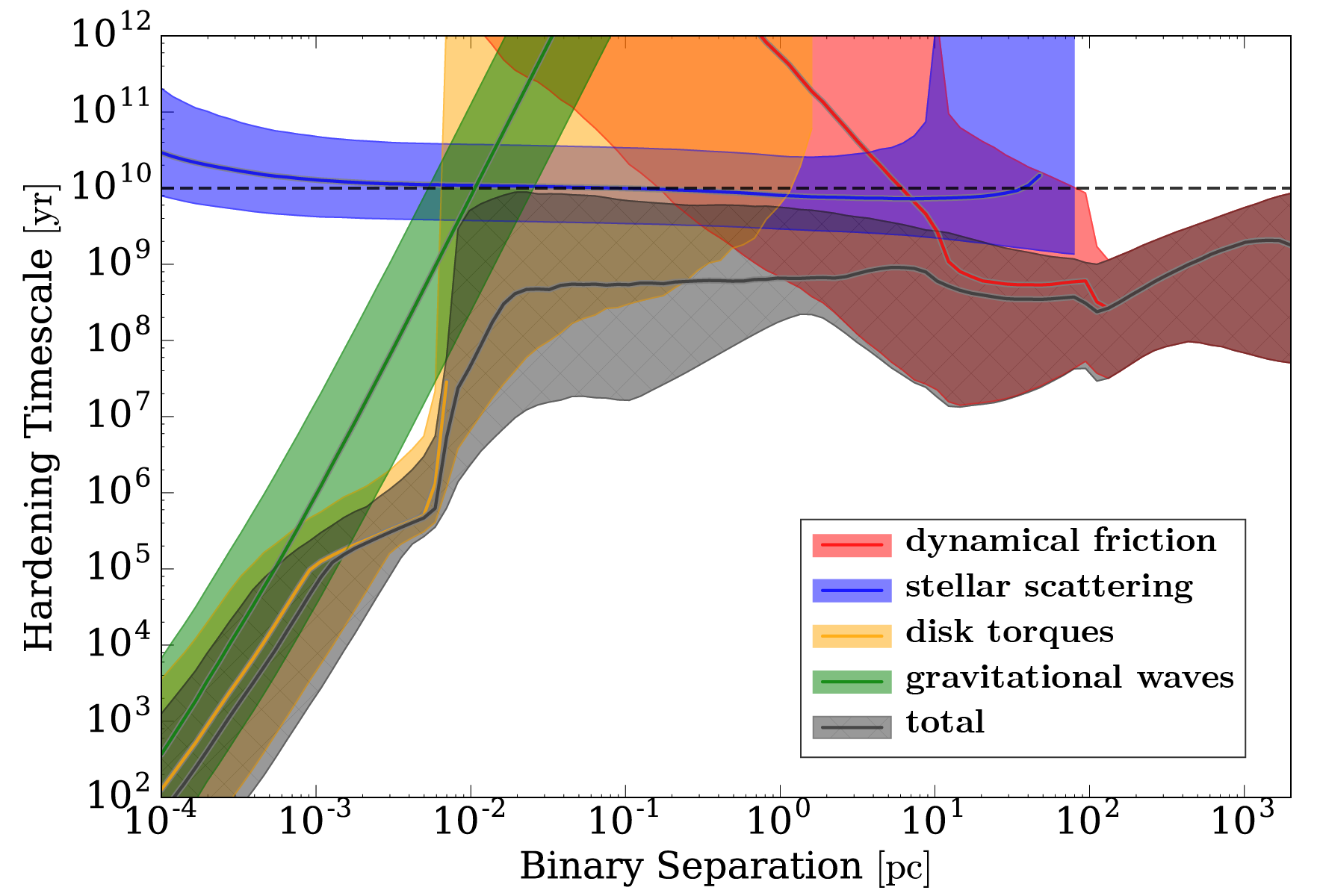
Two MBH are brought together during the merger of their host galaxies, which occurs on megaparsec scales. Only at about milliparsec separations can an MBH binary emit gravitational waves and eventually coalesce. The only way for the binary to traverse this vast range of scales is through environmental interactions, like dynamical friction and stellar scattering, with the host galaxy. This process typically takes billions of years and only a fraction of binaries coalesce at all.
During this process, a number of important processes are underway. Detailed circumbinary-disk models have recently shown that accretion onto the binary can favor the secondary, which can significantly alter the masses and dynamics. The spin of both MBHs also evolve over time, and if the spins are significant at the time of coalescence, can produce large recoil 'kicks' of the remnant—possibly ejecting it from the galaxy. Precision in the GW waveform might also be detectable with LISA.
Nanohertz Gravitational Waves
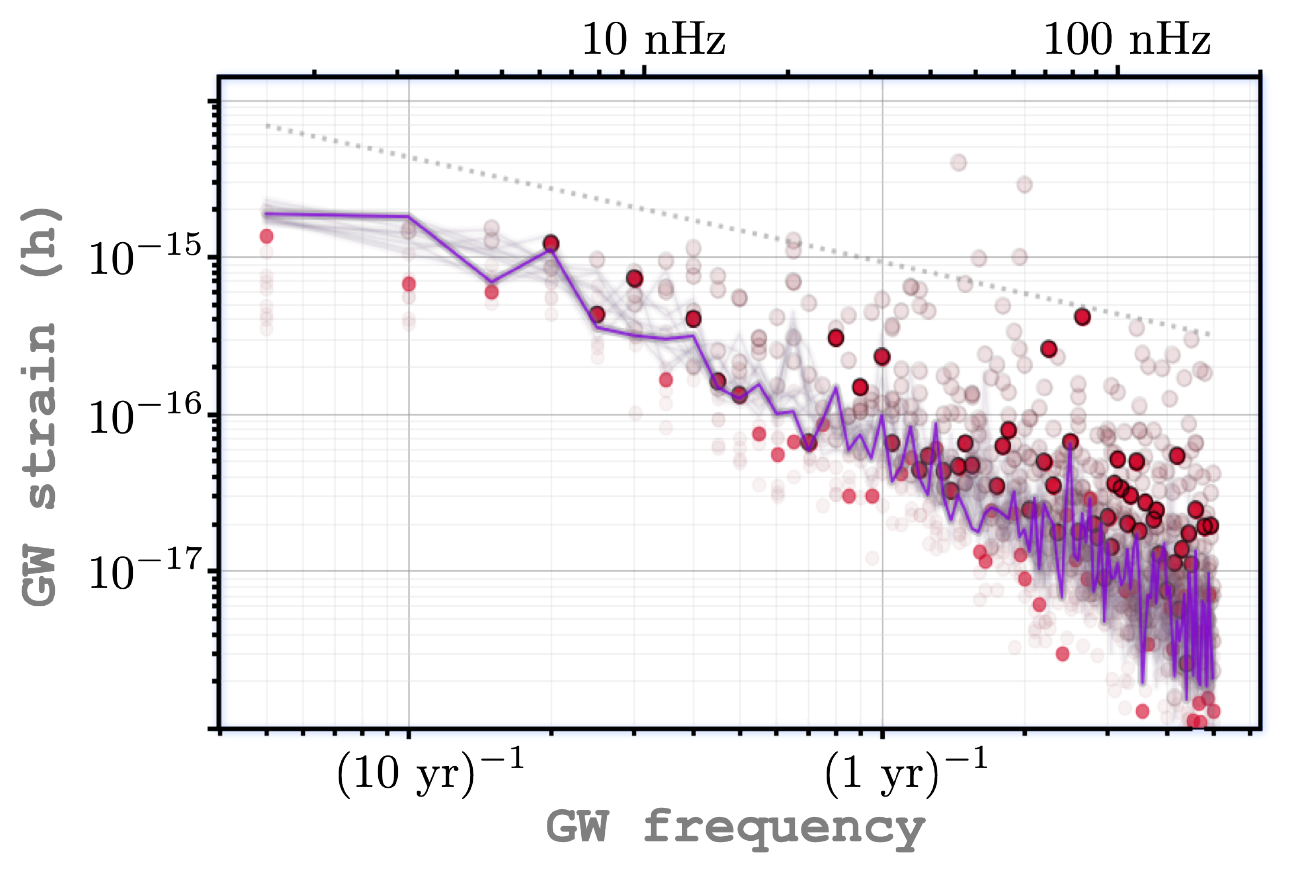
Once massive black hole binaries (MBHB) reach milliparsec scales, their GW emission becomes detectable by 'pulsar timing arrays'. There are generally three classes of signals: a stochastic 'GW Background' produced by the superposition of many binaries emitting across the Universe (purple lines), 'continuous GW' sources which are loud enough to resound above the background (red dots), and 'bursts' when the binaries finally coalesce.
The GW background encodes a huge amount of information about massive black holes, about their binary evolution, and even about their host galaxies. The low-frequency turnover in the background's spectrum, for example, tells us about how much binaries typically interact with their local stellar and gaseous environments. Continuous GW sources are also very exciting, particularly because we might be able to detect electromagnetic counterparts of those binaries, making them powerful multimessenger sources.
Multimessenger Astrophysics and EM Counterparts
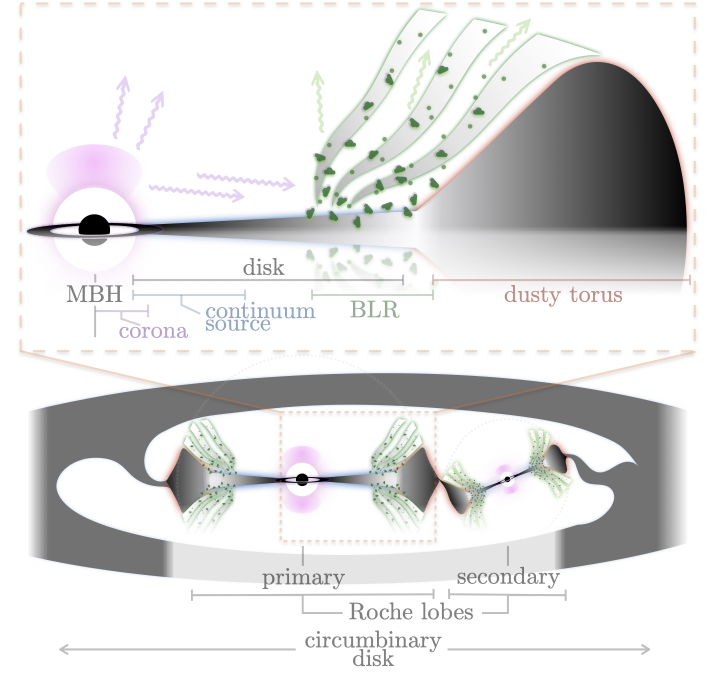
When massive black holes are accreting enough material to be observable, we call them active galactic nuclei (AGN). There are many possible EM signatures of AGN in binaries, particularly photometric periodic-variability and offset spectroscopic emission lines. In both cases large populations of candidate binaries have been identified, however, there is growing evidence that many (or even most) of them are false positives, due to the high intrinsic variability of single-AGN systems.
Determining robust EM signatures is very important as the detection of both GW and EM signatures from MBH binaries opens up a huge, new discovery space to constrain their binary evolution, host-galaxy interactions, and even to construct cosmological distance measurements.
LISA Gravitational Wave Sources

The future space-based LISA mission will detect gravitational waves from both massive BHs and stellar mass binaries. The massive black holes will be observable anywhere in the Universe, offering a unique opportunity to probe MBHs at high redshifts—--soon after their formation. The higher-redshift and lower-mass MBHs that are uniquely detectable by LISA are particularly difficult to model in cosmological simulations as they require very high resolution, and may also be rare (necessitating large simulation volumes). Analyzing the LISA data stream will also be particularly challenging because of the 'global fit': millions of sources will all be intertwined with the noise, necessitating a simultaneous fit of vast numbers of sources.
To tackle these challenges, our group (with Prof. Laura Blecha at the University of Florida) is developing a new generation of cosmological hydrodynamic simulation that can accurately resolve the population of 'seed' MBHs in the early Universe, and make testable predictions for both JWST and LISA. The results of these simulations will determine how we can map LISA observations of MBH-MBH mergers to determining how these objects are able to form and grow to large masses after so little time.
In a separate effort, we are developing a similar new suite of simulations, but this time geared towards stellar-mass binaries, and understanding their full, dynamical evolution in cosmological environments. We will use these simulations to study observed populations of SGRBs and LIGO detections (see below), and to make predictions for next generation ground-based interferometers like the proposed Cosmic Explorer and Voyager observatories. Our new cosmological simulations, of both MBH seeds, and stellar-mass binaries, will be crucial for LISA: in setting our priors and establishing our theoretical frameworks for performing the LISA global fit, and fully extracting the wealth of information that LISA will reveal.
Stellar Binaries and Short Gamma Ray Bursts (SGRBs)
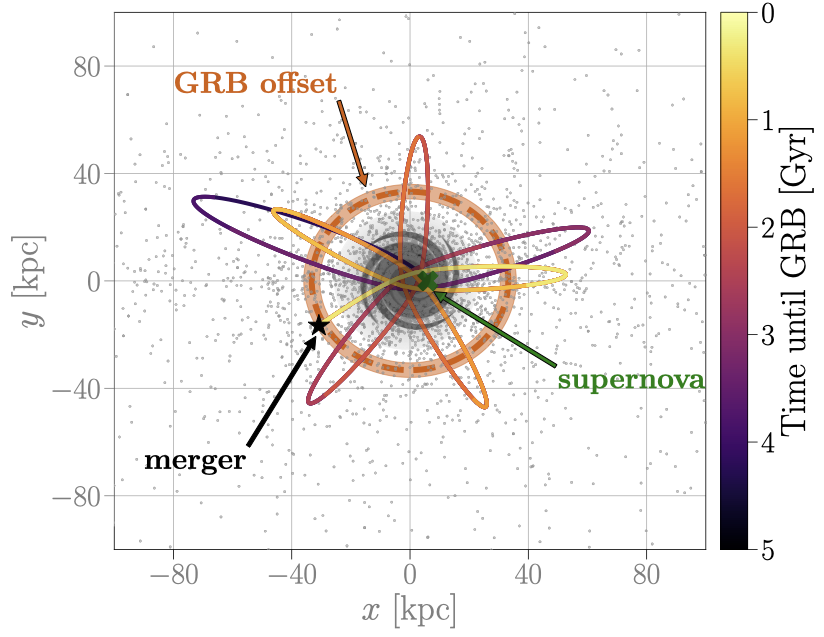
SGRBs are now known to be produced by the merger of neutron star (NS) binaries, which also produce (high-frequency) gravitational waves detectable with ground-based interferometers like LIGO-Virgo. These systems go through an exotic evolution: requiring two supernovae, typically a 'common envelope' phase, and then GW driven coalescence. During the supernovae, and associated mass-loss, the binary system can receive a large velocity 'kick', which can launch the system into wide orbits around the host galaxy, or even eject the system altogether.
I am very interested in the information that SGRBs and their host-galaxy environments can tell us. The location of mergers relative to the host galaxy encode information about the binary's formation, its lifetime, and its binary evolution. The explosive emission from the merger also serves as a precision probe of the local galaxy, and all of the intervening matter between it and Earth.
Tidal Disruption Events (TDEs)
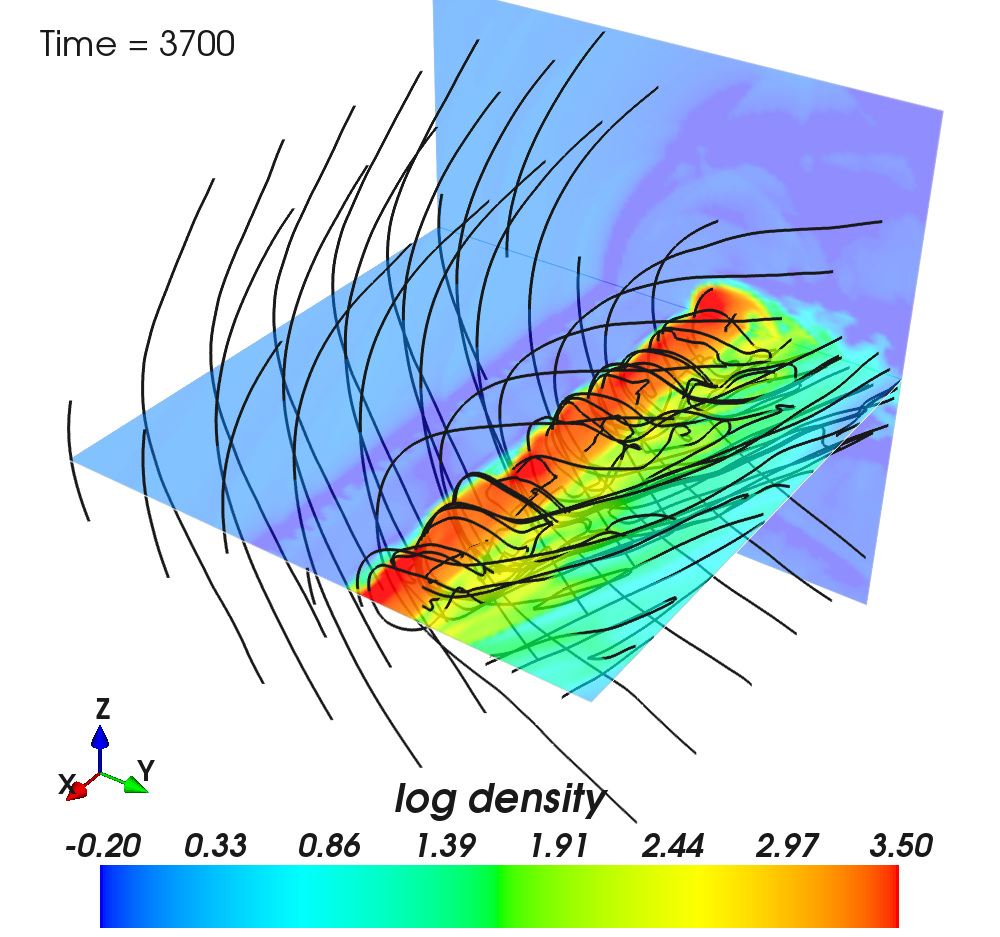
When a star passes too close to a massive black hole, the tidal gravitational forces can unbind the star—with some fraction of material accreted onto the MBH, and often powering bright emission, and some material ejected from the system. These tidal disruption events (TDEs), and the flares of electromagnetic emission they produce, provide an opportunity to observe MBHs that may otherwise be invisible. I'm particularly interested in the interactions between the TDE debris stream and any pre-existing accretion disk: TDEs also form a laboratory for 'perturbing' the standard structure of accretion disks, to see how they respond.
Another phenomenon, recently discovered, called 'changing look' AGN (active galactic nuclei), which may be related to TDEs, provide a similar opportunity to observe time-dependence in these systems which are usually in the same state for millions of years. Ongoing and upcoming surveys will deliver a vast amount of observational data that can be used to understand the detailed and time-dependent structure of AGN.
students / research group
-
Emiko Gardiner: graduate student (UC Berkeley, Astronomy)
-
Sophie Willis: undergraduate (UC Berkeley, Astrophysics & Applied Mathematics)
-
Katherine Liviakis undergraduate (SFSU)
-
Rodney Speight undergraduate (SDSU)
Magdalena Siwek PhD (Harvard; PI: Hernquist) → Junior Fellow, Simons Society of Fellows, CCA/Colombia
-
Aneesh Sivasankaran (UF; PI: Blecha) → Industry
-
Bence Bécsy PhD (Montana State, PI: Cornish) → Professor, University of Birmigham, UK
-
Michael Zevin PhD (Northwestern; PI: Kalogera) → Astrophysicist, Adler Planetarium
-
Michael Katz PhD (Northwestern; PI: Larson) → Postdoc, NASA Marshall
-
Mohammad Sayeb PhD (UF; PI: Blecha) → Industry
-
Katherine Cella: undergraduate (Vanderbilt; PI: Taylor) → Industry
-
Megan Tillman: undergraduate (Texas A&M; PI: Faucher-Giguere) → Rutgers
-
Estephani TorresVillanueva: undergraduate (Northwestern REU) → UW Madison
-
Sophia Taylor: undergraduate (Northwestern REU) → Industry
- Tenley Hutchinson: undergraduate (Harvard Banneker Institute) → UC Santa Cruz (PI: Ramirez-Ruiz)
